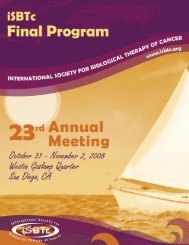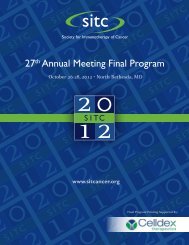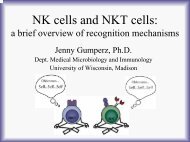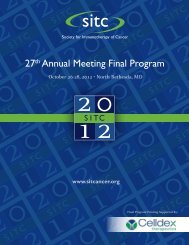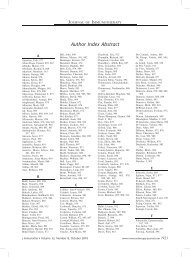Abstracts for the 25th Annual Scientific Meeting of the International ...
Abstracts for the 25th Annual Scientific Meeting of the International ...
Abstracts for the 25th Annual Scientific Meeting of the International ...
Create successful ePaper yourself
Turn your PDF publications into a flip-book with our unique Google optimized e-Paper software.
J Immuno<strong>the</strong>r Volume 33, Number 8, October 2010<br />
<strong>Abstracts</strong><br />
In 5 out <strong>of</strong> 6 evaluable patients continuing treatment, <strong>the</strong> response<br />
to MVA was boosted, and in 4 out <strong>of</strong> 6 evaluable patients,<br />
transgene responses increased ei<strong>the</strong>r in magnitude and or in<br />
breadth. Fur<strong>the</strong>rmore, continued treatment did not impact<br />
regulatory T cell (Treg) levels, which predominantly remained<br />
stable with a few patients showing reduced Treg levels upon<br />
continued vaccination.<br />
Overall, this analysis indicates that MVA-BN s -PRO can break<br />
tolerance against PSA and/or PAP in cancer patients. It also<br />
suggests that transgene-specific immunity can be achieved in<br />
patients despite <strong>the</strong> pre-existence or co-induction <strong>of</strong> strong anti-<br />
MVA responses. Based on this interim analysis and contingent<br />
upon complete and confirmatory results, it appears that MVA-<br />
BN s -PRO is a biologically active treatment <strong>for</strong> patients with nonmetastatic<br />
CRPC.<br />
In Vivo Modeling and Detection <strong>of</strong> Ovarian Cancer Vascular<br />
Marker TEM1<br />
Chunsheng Li*, Kosei Hasegawa*, Ann-Marie Chackow, Vladimir<br />
Muzykantovw, Chaitanya Divgiz, Phyllis A. Gimottyy, Luigi<br />
GrassoJ, George Coukos*. *Ovarian Cancer Research Center;<br />
w Translational Medicine and Therapeutics, and Environmental<br />
Medicine; Departments <strong>of</strong> zRadiology; yBiostatistics and Epidemiology,<br />
Univ <strong>of</strong> Pennsylvania, Philadelphia; JMorphotek, Inc, Exton,<br />
PA.<br />
Rationale: Epi<strong>the</strong>lial ovarian cancer (EOC) remains <strong>the</strong> most<br />
deadly cancer without efficient detection and eradication methods.<br />
TEM1 is overexpressed specifically in <strong>the</strong> vasculature <strong>of</strong> various<br />
tumors and has been implicated in promoting adhesion, invasion<br />
and metastasis. Since EOC responds well to vascular-targeted<br />
<strong>the</strong>rapy, we hypo<strong>the</strong>size that TEM1 is a tumor vascular marker<br />
with diagnostic and <strong>the</strong>rapeutic potential.<br />
Specific Aims: (1) To characterize TEM1 expression in normal<br />
tissues and EOC samples; (2) to establish huTEM1 murine tumor<br />
vasculature model; (3) to develop a TEM1-specific PET imaging<br />
strategy.<br />
Methods: qPCR and IHC are used to characterize huTEM1<br />
expression in normal and EOC samples. Luciferase positive<br />
huTEM1 expressing murine endo<strong>the</strong>lial cell (huTEM1+ EC) lines<br />
were established and injected alone or with tumor cells onto nude<br />
mice and monitored by bioluminescent imaging.<br />
An antiTEM1 Ab, MORAb004, was radiolabeled with 124I and<br />
injected venously. PET images were acquired at various time points<br />
to visualize hTEM1+ECs in vivo and corresponding biodistribution<br />
studies were per<strong>for</strong>med.<br />
Results: (1) High TEM1 mRNA level correlates with poor outcome<br />
in 2 cohorts <strong>of</strong> EOC patients. (2) Positive TEM1 staining was<br />
observed in most EOC tissues studied, while no positive staining<br />
was seen in controls. (3) TEM1 expression in huTEM1+ ECs was<br />
confirmed by qPCR, western and FACS analysis. (4) huTEM1+<br />
and control ECs can be detected in nude mice 5 weeks p.i.5)<br />
[124I]MORAb004 has been successfully labeled in high yield and<br />
without loss <strong>of</strong> immunoreactivity. (6) PET images revealed specific<br />
retention <strong>of</strong> [124I]MORAb004 in huTEM1+ xenografts and no<br />
discernible uptake in control <strong>of</strong> <strong>the</strong> same animal. The radioactivity<br />
in TEM1+ tumor lasted >6 days p.i. (7) Ex vivo biodistribution<br />
study at 48 hours p.i. revealed hTEM1+ xenograft to nontarget<br />
ratios (T/NT) upwards <strong>of</strong> 16, 84, and 9 <strong>for</strong> blood, muscle, and<br />
control xenograft, respectively.<br />
Conclusions: (1) Our data suggest that TEM1 is a rational<br />
diagnostic and <strong>the</strong>rapeutic target <strong>for</strong> EOC. (2) We developed<br />
PET imaging strategy to visualize huTEM1+ cells in mouse model.<br />
(3) Our murine vascular model allows quantitative and specific<br />
monitoring <strong>of</strong> ECs by optical and PET imaging, <strong>the</strong>re<strong>for</strong>e serves as<br />
an unprecedented plat<strong>for</strong>m <strong>for</strong> studying <strong>the</strong> function <strong>of</strong> tumor<br />
vascular markers, as well as testing new diagnostics and <strong>the</strong>rapeutic<br />
agents against tumor vasculature in vivo. (4) Fur<strong>the</strong>r studies will<br />
evaluate TEM1 as early detection marker and prognostic factor <strong>for</strong><br />
EOC.<br />
Analysis <strong>of</strong> Intra-Tumor Immunological Changes Induced by<br />
Immunization with Two-Component Messenger RNA-Based<br />
Anti-Cancer Vaccines<br />
Christina Lorenz, Mariola Fotin-Mleczek, Katharina M. Duchardt,<br />
Karl-Josef Kallen. CureVac GmbH, Tübingen, Germany.<br />
Two-component tumor mRNA-based vaccines exhibit two principle<br />
activities: antigen expression and concomitant immune<br />
stimulation. Thus, innate as well as adaptive immune responses<br />
are induced. Intradermal vaccination <strong>of</strong> tumor-bearing mice with<br />
<strong>the</strong> two-component mRNA vaccine mediates a strong anti-tumor<br />
response under <strong>the</strong>rapeutic conditions. Depletion experiments<br />
demonstrate <strong>the</strong> requirement <strong>of</strong> CD8 T cells <strong>for</strong> <strong>the</strong> anti-tumor<br />
effect and <strong>the</strong> necessity <strong>of</strong> CD4 T cell help <strong>for</strong> <strong>the</strong> induction <strong>of</strong><br />
antigen-specific CTLs. FACS analysis <strong>of</strong> tumor tissue revealed<br />
increased infiltration <strong>of</strong> activated CD8 T cells and <strong>the</strong>ir prolonged<br />
persistence at <strong>the</strong> tumor site in response to vaccination. Moreover,<br />
<strong>the</strong>rapeutic vaccination inhibited a tumor-induced increase <strong>of</strong><br />
myeloid derived suppressor cells (MDSCs) in <strong>the</strong> spleen and at <strong>the</strong><br />
tumor site.<br />
To fur<strong>the</strong>r elucidate <strong>the</strong> mechanism <strong>of</strong> our mRNA-based anticancer<br />
vaccine, tumor-bearing mice were vaccinated repeatedly and<br />
tumors were removed at different time points. Microarray analysis<br />
<strong>of</strong> total mRNA extracted from removed tumors revealed clear<br />
differences between vaccinated and control mice. Already after two<br />
vaccinations, be<strong>for</strong>e <strong>the</strong> effect on tumor size became visible, a wide<br />
variety <strong>of</strong> immune response related genes was upregulated in<br />
vaccinated mice. A large proportion <strong>of</strong> <strong>the</strong>se genes is associated<br />
with activation and cytotoxicity <strong>of</strong> NK and T cells, Th1<br />
polarization or chemotaxis.<br />
Our findings conclusively demonstrate <strong>the</strong> comprehensive nature <strong>of</strong><br />
<strong>the</strong> immune response induced by our mRNA based vaccines and<br />
<strong>the</strong> variety <strong>of</strong> pathways involved in <strong>the</strong> anti-tumor effect. Better<br />
understanding <strong>of</strong> <strong>the</strong> mode <strong>of</strong> action allows fur<strong>the</strong>r improvement <strong>of</strong><br />
our vaccine approach and <strong>the</strong> selection <strong>of</strong> potential targets <strong>for</strong><br />
combination <strong>the</strong>rapies. Additionally, <strong>the</strong> approach opens new<br />
possibilities <strong>for</strong> targeted monitoring <strong>of</strong> induced immune responses.<br />
Targeting <strong>of</strong> Mortalin-Mutant p53 Interactions by Mortalin<br />
shRNA Leads to Selective Apoptotic Death <strong>of</strong> Human<br />
Hepatocellular Carcinoma<br />
Wen Jing Lu*, Nikki P. Lee*, Ronnie T.P. Poon*, Sunil C. Kaulw,<br />
Renu Wadhwaw, John M. Lukz. *Surgery, The University <strong>of</strong><br />
Hong Kong, Hong Kong; w National Institute <strong>of</strong> Advanced Industrial<br />
Science & Technology (AIST), Tsukuba, Japan; zNational University<br />
<strong>of</strong> Singapore, Singapore, Singapore.<br />
Restoration <strong>of</strong> deregulated apoptotic pathway is one <strong>of</strong> <strong>the</strong> main<br />
strategies <strong>for</strong> cancer <strong>the</strong>rapeutics. Mortalin/mitochondria heat<br />
shock protein 70 (mtHSP70) is a stress protein that is overexpressed<br />
in cancer cells and tissues, which has been proposed to have a role<br />
in human carcinogenesis. It was previously shown that mortalin<br />
interacts with wild type tumor suppressor protein p53 resulting<br />
in abrogation <strong>of</strong> its transcriptional activation and control <strong>of</strong><br />
centrosome duplication functions, both tightly related to cancer<br />
development. Normal human fibroblasts were shown to lack<br />
mortalin-wild type p53 interactions. It was also identified as a<br />
marker <strong>for</strong> hepatocellular carcinoma (HCC) metastasis and<br />
recurrence by proteomics analysis <strong>of</strong> matched tumor and nontumor<br />
tissues. In this study, we examined mortalin expression in<br />
100 HCC patients and found that its upregulation has strong<br />
correlation with tumor stage and microsatellite <strong>for</strong>mation. In order<br />
to validate <strong>the</strong> critical role <strong>of</strong> mortalin in HCC development and<br />
progression, we recruited its shRNA in eight HCC-derived cell lines<br />
varying in p53 status (loss/mutant p53/wild type). MortalinshRNA<br />
caused apoptosis in most, but not all, HCC cell lines. By<br />
examination <strong>of</strong> mortalin-p53 interactions and molecular pathway<br />
<strong>for</strong> apoptosis, we found that induction <strong>of</strong> apoptosis by mortalinshRNA<br />
depended on occurrence <strong>of</strong> mortalin-mutant p53 interactions;<br />
<strong>the</strong> cell lines that lacked <strong>the</strong>se interactions escaped apoptosis.<br />
Most importantly, mortalin-p53 interactions were induced by<br />
r 2010 Lippincott Williams & Wilkins www.immuno<strong>the</strong>rapy-journal.com | 901



